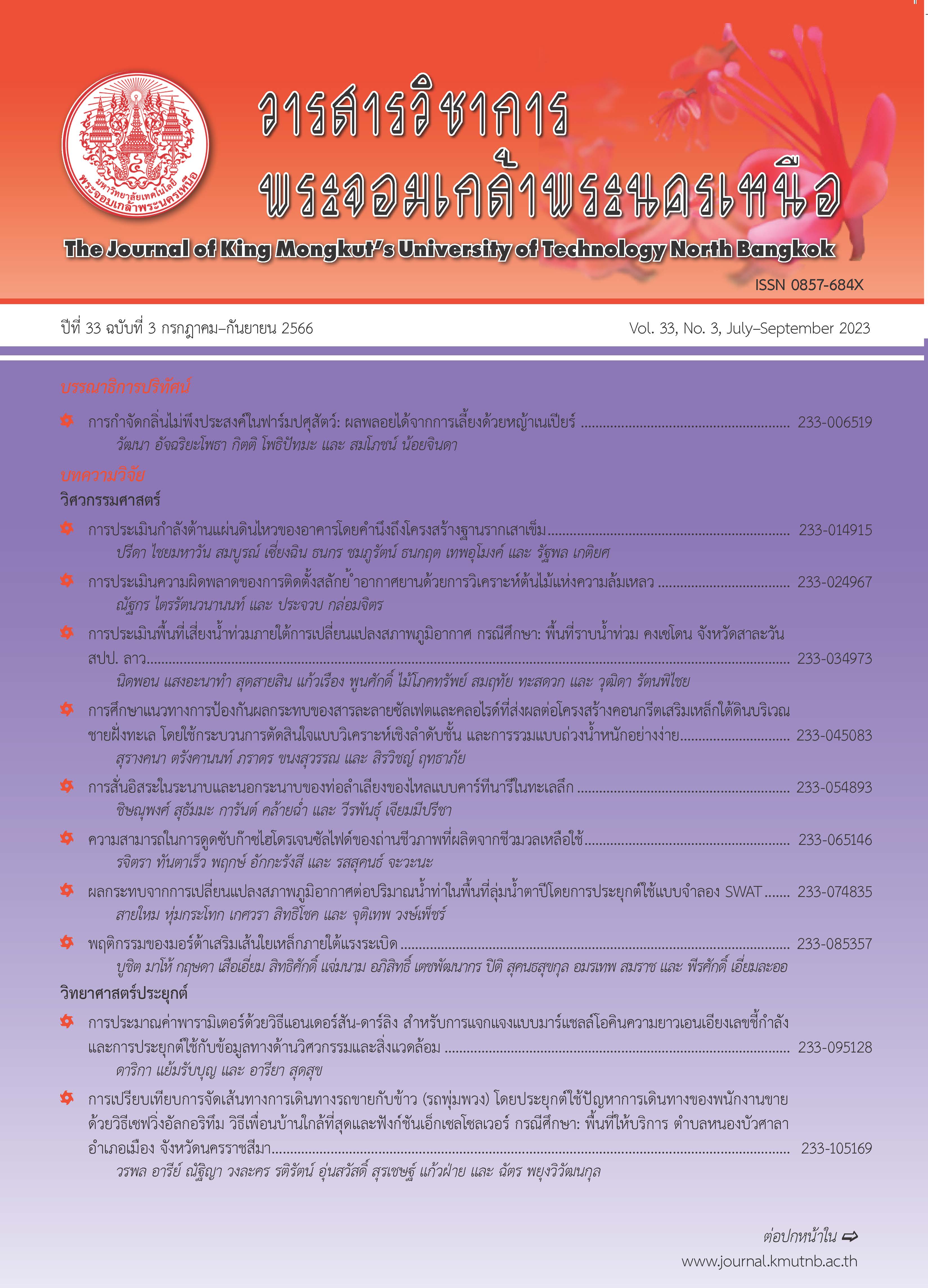การประเมินกำลังต้านแผ่นดินไหวของอาคารโดยคำนึงถึงโครงสร้างฐานรากเสาเข็ม
Main Article Content
บทคัดย่อ
บทความนี้นำเสนอผลการศึกษาเปรียบเทียบผลการประเมิน และผลตอบสนองของโครงสร้างอาคารต้านแผ่นดินไหวโดยใช้สเปกตรัมในพื้นที่จังหวัดพะเยา ด้วยแบบจำลองโครงสร้างอาคารที่มีเฉพาะโครงสร้างด้านบนเพียงอย่างเดียว และแบบจำลองที่มีทั้งโครงสร้างด้านบนและโครงสร้างฐานรากพร้อมกัน โดยโครงสร้างฐานรากได้ใช้เสาเข็มและสปริงเพื่อแทนผลของดินที่อยู่ด้านข้างเสาเข็ม ผลการศึกษาพบว่า แบบจำลองอาคารที่มีทั้งโครงสร้างด้านบนและโครงสร้างเสาเข็มพร้อมกัน ทำให้คาบธรรมชาติในโหมดพื้นฐานเพิ่มขึ้น และมีรูปแบบและสัดส่วนการสั่นไหวที่แตกต่างจากแบบจำลองที่ไม่มีเสาเข็ม แบบจำลองที่มีเสาเข็มมีสติฟเนสการต้านแรงด้านข้างลดลงแต่ไม่ได้ลดแรงต้านสูงสุดของอาคาร และถูกประเมินด้วยแรงแผ่นดินไหวที่ลดลงจึงพบระดับความเสียหายที่ลดลงด้วย ผู้วิจัยได้ทดลองเปลี่ยนลักษณะชั้นดินให้มีความแตกต่างกันพบว่า การคำนึงถึงการวิเคราะห์โครงสร้างอาคารที่คำนึงถึงโครงสร้างฐานรากจะช่วยลดแรงแผ่นดินไหวที่ใช้ประเมินได้มากในกรณีดินที่อ่อน แต่โครงสร้างอาคารจะมีการเสียรูปที่มากขึ้น ดังนั้นการจำลองโครงสร้างอาคารจำเป็นต้องพิจารณาโครงสร้างฐานรากในกรณีที่อาคารอยู่บนดินอ่อนเพื่อให้ประเมินสมรรถนะของของอาคารได้อย่างเหมาะสม
Article Details

อนุญาตภายใต้เงื่อนไข Creative Commons Attribution-NonCommercial-NoDerivatives 4.0 International License.
บทความที่ลงตีพิมพ์เป็นข้อคิดเห็นของผู้เขียนเท่านั้น
ผู้เขียนจะต้องเป็นผู้รับผิดชอบต่อผลทางกฎหมายใดๆ ที่อาจเกิดขึ้นจากบทความนั้น
เอกสารอ้างอิง
J. Bielak, “Dynamic response of non-linear building-foundation systems,” Earthquake Engineering Structure Dynamic, vol. 6, pp. 17–30, 1978.
M. A. Ghannad and H. Jahankhah, “Sitedependent strength reduction factors for soil– structure systems,” Soil Dynamic Earthquake Engineering, vol. 27, no. 2, pp. 99–110, 2007.
M. Moghaddasi, M. Cubrinovski, J. G. Chase, S. Pampanin, and A. Carr, “Probabilistic evaluation of soil–foundation–structure interaction effects on seismic structural response,” Earthquake Engineering Structure Dynamic, vol. 40, pp. 135–154, 2011.
W. Sae-Long, S. Limkatanyu, C. Hansapinyo, T. Imjai, and M. Kwon, “Forced-based shearflexure- interaction frame element for nonlinear analysis of non-ductile reinforced concrete column,” Journal of Applied and Computation Mechanics, vol. 6, pp. 1151–1167, 2020.
W. Sae-Long, S. Limkatanyu, P. Panedpojaman, W. Prachasaree, N. Damrongwiriyanupap, M. Kwon and C. Hansapinyo, “Nonlinear winkler-based frame element with inclusion of shear-flexure interaction effect for analysis of non-ductile rc members on foundation,” Journal of Applied and Computation Mechanics, vol. 7, no. 1, pp. 148–164, 2021.
A. Pimanmas, P. Chaimahawan, and P. Joyklad. Advanced Reinforced Concrete Foundation Structure Design, Bangkok: Civil Engineering Consultant and Training Co. ltd., 2012 (in Thai).
M. T. Davisson, “Latetal load capacity of pile,” in 49th Annual Meeting of the Highway Research Board, Washington District of Columbia, United States, 1970, pp. 101–112.
K. Terzaghi, “Evaluation of coefficients of subgrade reaction,” Geotechnique, vol. 5, pp. 297–326, 1955.
Seismic Evaluation and Strengthening of Buildings and Structures, National Standard DPT-1303-57, 2014 (in Thai).
Seismic Resistant Design of Buildings and Structures, National Standard DPT-1301/ 1302-61, 2018 (in Thai).
P. Chaimahawan, P. Wongrat, and T. Chompoorat, “Seismic response spectrum curve created from site exploration in Phayao province,” Engineering Journal of Research and Development, vol. 28, no. 3, pp. 15–26, 2017 (in Thai).
P. Wongrat, A. Buakla, T. Chompoorat, and P. Chaimahawan, “Earthquake effect to liquefaction potential in Phayao province,” Research and Development, vol. 31, no. 4, pp. 87–99, 2020.
Applied Technology Council, Seismic Evaluation and Retrofit of Concrete Buildings, ATC-40 Report, Redwood City, California., 1996.

